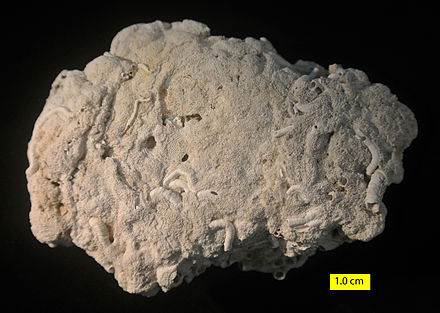Bryozoa
Bryozoa (also known as the Polyzoa, Ectoprocta or commonly as moss animals)[5] are a phylum of simple, aquatic invertebrate animals, nearly all living in sedentary colonies. Typically about 0.5 millimetres (1⁄64 inch) long, they have a special feeding structure called a lophophore, a "crown" of tentacles used for filter feeding. Most marine bryozoans live in tropical waters, but a few are found in oceanic trenches and polar waters. The bryozoans are classified as the marine bryozoans (Stenolaemata), freshwater bryozoans (Phylactolaemata), and mostly-marine bryozoans (Gymnolaemata), a few members of which prefer brackish water. 5,869 living species are known.[6] One genus is solitary; all the rest are colonial.
The terms "Polyzoa" and "Bryozoa" were introduced a year apart, in 1830 and 1831 respectively.[7][8] Soon after it was named, another group of animals was discovered whose filtering mechanism looked similar, so it was included in Bryozoa until 1869, when the two groups were noted to be very different internally. The new group was given the name "Entoprocta", while the original Bryozoa were called "Ectoprocta". Disagreements about terminology persisted well into the 20th century, but "Bryozoa" is now the generally accepted term.[9][10]
Colonies take a variety of forms, including fans, bushes and sheets. Single animals, called zooids, live throughout the colony and are not fully independent. These individuals can have unique and diverse functions. All colonies have "autozooids", which are responsible for feeding, excretion, and supplying nutrients to the colony through diverse channels. Some classes have specialist zooids like hatcheries for fertilized eggs, colonial defence structures, and root-like attachment structures. Cheilostomata is the most diverse order of bryozoan, possibly because its members have the widest range of specialist zooids. They have mineralizedexoskeletons and form single-layered sheets which encrust over surfaces, and some colonies can creep very slowly by using spiny defensive zooids as legs.
Each zooid consists of a "cystid", which provides the body wall and produces the exoskeleton, and a "polypide", which holds the organs. Zooids have no special excretory organs, and autozooids' polypides are scrapped when they become overloaded with waste products; usually the body wall then grows a replacement polypide. Their gut is U-shaped, with the mouth inside the crown of tentacles and the anus outside it. Zooids of all the freshwater species are simultaneous hermaphrodites. Although those of many marine species function first as males and then as females, their colonies always contain a combination of zooids that are in their male and female stages. All species emit sperm into the water. Some also release ova into the water, while others capture sperm via their tentacles to fertilize their ova internally. In some species the larvae have large yolks, go to feed, and quickly settle on a surface. Others produce larvae that have little yolk but swim and feed for a few days before settling. After settling, all larvae undergo a radical metamorphosis that destroys and rebuilds almost all the internal tissues. Freshwater species also produce statoblasts that lie dormant until conditions are favorable, which enables a colony's lineage to survive even if severe conditions kill the mother colony.



